- Basic information
- Workshops and guides
- Managing references
- Library Lookup – your connection to the WU catalog
- Using Juris-M in Word
Basic information
The reference management software Juris-M is an extended version of the open-source software Zotero with special features for legal citation.
Installation
The Juris-M reference management software is an open source program and can be downloaded free of charge on the Juris-M homepage for MS Windows, Mac OS X, and Linux operating systems.
Please note: We recommend installing the Juris-M browser plugin in order to get the most out of Juris-M when importing from databases. The plugin is available for Firefox, Chrome, and Safari.
You will also need to install the appropriate plugin to be able to use Juris-M with your word processing software. Plugins are available for MS Word and LibreOffice.
Information for WU staff
To install Juris-M on WU work computers, please download the program via the Software Center in your computer’s start menu. Updates for the software can be done independently by activating Check for updates… under the tab Help in Juris-M.
Online synchronisation
If you want to share your references with others or synchronize your reference library to different devices, you will need a free Zotero account, which you can set up on the Zotero homepage. The number of literature references you can save is unlimited, but for attached files (e.g. PDFs), storage space is limited to 300 MB. Additional storage space can be purchased if necessary.
To synchronize Juris-M entries with your Zotero account, the data from the extended fields in Juris-M is packaged in a block starting with “mlzsync” in the Extra field. Please edit this field in the web library only if you know exactly what you are doing.
Please note: The data of Zotero accounts is processed outside of the European Economic Area (EEA). You can find further information on this here.
Workshops and guides
The WU Library regularly offers introductory courses for Juris-M and other reference management software. You can find the current schedule on our website.
search_bar
In addition, every Tuesday you have the opportunity to visit the search_bar – no registration necessary! The search_bar offers advice on all questions concerning reference management.
Guides
Below you can find an overview of the most important functions and WU-specific settings.
Managing references
Creating references manually
- Select File » New Item or click the New Item button in the Juris-M toolbar

- Select the document type: This will define which fields are available and how the citation and bibliographic entry will be formatted.
- Fill out the required bibliographic data. Please note the formal requirements for entering names.
Entering names
Juris-M offers two options for entering names. You can switch between the options using the button next to the entry field:

In two-field mode, the author’s last name is entered in the first field and the first name (including aristocratic titles) in the second. One-field mode is used for entering the names of organizations, research institutions, or other facilities acting as author or editor.
For each new author, press the plus button for a new field where you can enter the name of a person or institution.
You can assign roles (author, editor, etc.) by clicking the Author ![]() button.
button.
Automatically adding references
Importing references
Most databases offer a number of different export options, and Juris-M is compatible with several file formats. In most cases the formats RIS or BibTeX are available, both of which can be opened directly with Juris-M or imported using File » Import.
Searching via ISBN, DOI or PMID
Juris-M allows you to search for literature references via pre-existing numeric identifier (ISBN, DOI or PMID) and to import them directly into your database. Click on the symbol of the magic wand in the Juris-M toolbar, enter the identifier, then press Enter.

Using the browser plugins
The typical way to import references from databases, library catalogs, and other online sources into Juris-M is by using the browser plugins. These plugins can detect how the bibliographic data is formatted based on the webpage address and import it directly into your Juris-M library. Unfortunately, the plugins currently recognize only few legal sources.
A simple click on the plugin’s logo creates an entry in Juris-M. The logo itself indicates the type of data the plugin recognizes on the current page. Right-clicking on the logo also provides additional options under Save to Juris-M.
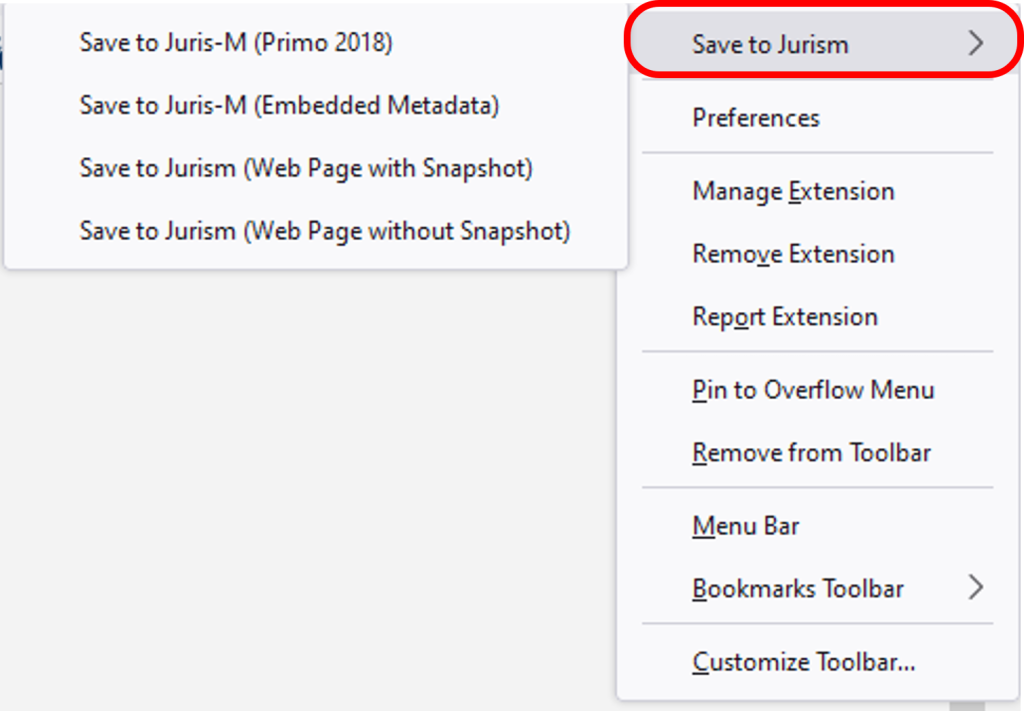
If a page has multiple literature entries to choose from, you’ll see a folder icon. From there, you can select the entries on the page that you want to save.

Whenever possible, the PDF version of a journal article on the page will be saved in Juris-M. If that’s not possible, in most cases, a snapshot of the webpage will be stored as a local copy in Juris-M.
Managing collections
Zotero allows users to create collections to sort references: Right-click on My Library and click on New Collection… or click on the file button ![]() to create a new collection. You can also make subcollections by right-clicking on an existing collection and selecting New Subcollection….
to create a new collection. You can also make subcollections by right-clicking on an existing collection and selecting New Subcollection….
You can simply drag and drop entries from the list onto the collection name to add them to that collection. Of course you can also assign entries to a collection while creating them using the Juris-M Connector.

To find out which collections an entry belongs to, just select the entry and hold down the Ctrl key (on Windows) or the Option key (on Mac).
Library Lookup – your connection to the WU catalog
Once you have the title data of a document in Juris-M, you can use the Library Lookup function to check if the document itself is available to you through the WU catalog.
Setting up Library Lookup
Open Zotero’s settings (Windows: Edit » Preferences, Mac OS: Zotero » Preferences).
A new window will appear. In that window, select Advanced at the top. Then, in the General tab, under OpenURL in the field Resolver, enter the URL https://openurl.wu.ac.at/resolve. Confirm this entry by clicking OK.
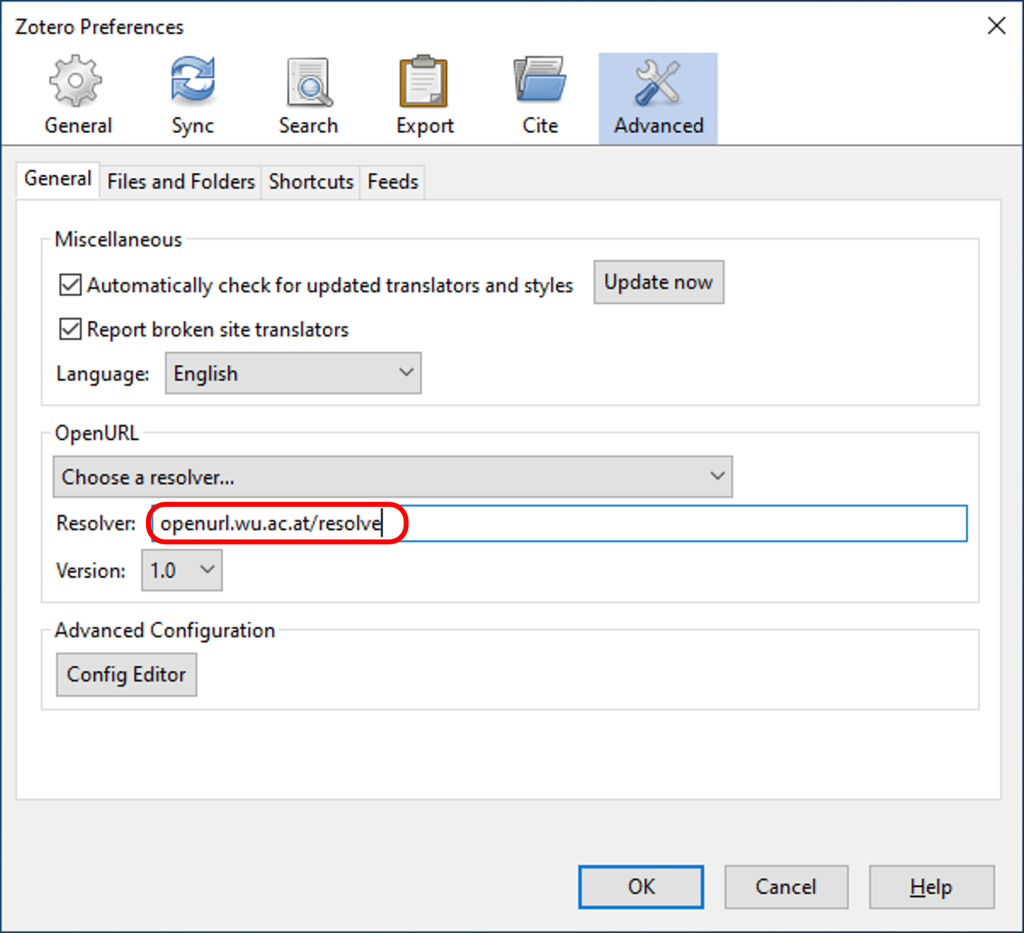
Using Library Lookup
Click once to select a record in your collection. Now, click the green “Locate”-arrow above the record’s information.
From the menu, choose Library Lookup. Zotero will open the page of the record in the WU Catalog in a browser window, allowing you direct access to the document, depending on its availability. To access a document online, you need to be connected to the WU network. You can find more details on how to access online-resources here.

Using Juris-M in Word
Managing citation styles
Citation styles determine how citations in the text and the bibliography are formatted. Juris-M offers a large choice of different styles. Under Tools » Preferences » Cite » Styles you can select a style, or use the Get additional styles… function to import additional styles. If the style you need is not available in Juris-M, please contact the library at library@wu.ac.at.
Installing the Word plug-in
Go to Edit » Preferences » Cite » Word Processors to install plugins for Juris-M Standalone.
Document preferences
Entering your first citation will open the Document Preferences window, where you can determine the citation style, language, and other settings. You can click on the Document Preferences button ![]() in the Juris-M toolbar in Word to change these settings later as required. The specific citation styles that utilize the extra features of Juris-M compared to Zotero all start with JM-.
in the Juris-M toolbar in Word to change these settings later as required. The specific citation styles that utilize the extra features of Juris-M compared to Zotero all start with JM-.
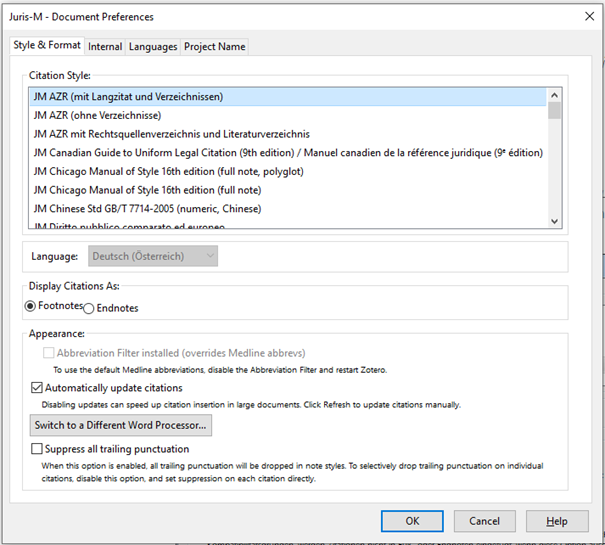
Inserting a citation
- In your text, place the cursor where you want to insert your citation.
- Click on Add/Edit Citation in the Juris-M toolbar.
- Enter the author or title of your reference in the search window. You can restrict your results to the year of publication, as well.
- Select on the reference you want to insert.
- Click on the name to add any page numbers, prefixes, or suffixes.
- Press Enter.
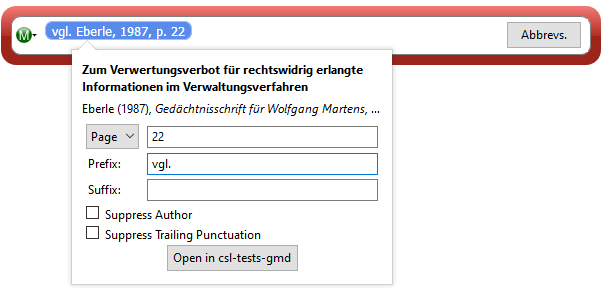
If the selected citation style requires footnotes, a footnote with the citation will be automatically created.
Please note: A space between the prefix and the citation itself must be entered manually in the prefix field! The same applies to spaces before a suffix.
Long footnotes
Often, there should be text before or after a reference in the footnote that doesn’t necessarily have to be directly related to the citation or is simply too long for the prefix field. In such cases, you can freely insert text before or after the reference in the footnote. If necessary, use the Suppress Trailing Punctuation function for trailing text.
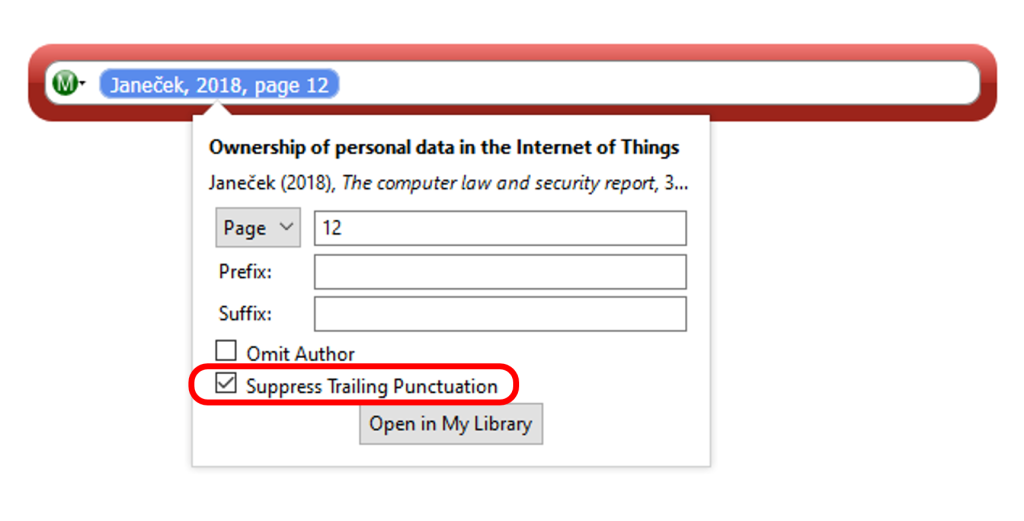
Parallel citations
To insert parallel citations, add a Juris-M citation and then select all the source entries you want to include. If necessary, disable the Keep Sources Sorted function to maintain the desired order.
For the sake of clarity, it can be helpful to use the Classic View. In the Classic View, you’ll need to click on Multiple Sources to enter the parallel source references.
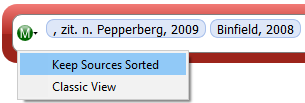
Bold or italicized prefixes/suffixes
To italicize text in the prefix and suffix fields, you need to enclose it between <i> and </i>. Similarly, to make text bold, use <b> … </b>:
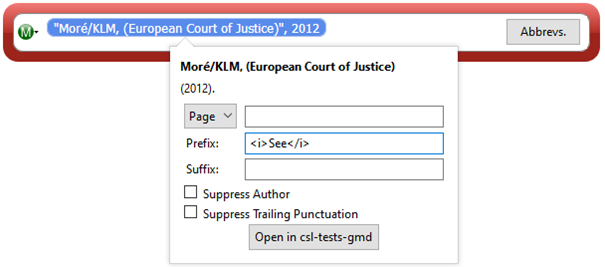
Please note: If you are using an English-language citation style that requires italicized “signals” (See, See e.g., Cf.,…), you can access a list of the common “signals” that are automatically italicized in the prefix field by pressing Ctrl+S (Windows) or Cmd+S (Mac).
Inserting secondary citations
Please note: Generally, secondary citations are best avoided in academic writing and should only be used if it is impossible to obtain the original source.
If you want to create a secondary citation in the form of “Reference 1 2021, as cited in Reference 2 2021,” where both references appear in the bibliography, you can do it as follows:
- Insert both references using Juris-M.
- In the prefix of the second citation, enter the text “, as cited in “. It’s important that the prefix starts with a comma; otherwise, in most citation styles, a semicolon will be inserted.
If the citation style automatically sorts the references within the citation, disable sorting for this citation. To do this, click on the Juris-M icon in the red citation dialog and uncheck the Keep Sources Sorted option.

Editing and deleting citations
To add page numbers or prefixes like cf., see, etc., place your cursor in the reference to be edited and click Add/Edit Citation. A Juris-M window will appear in which you can enter your changes.
Use the Delete or Backspace keys on your keyboard to delete references.
Important note: Do not directly edit the gray-highlighted citation text in Word! Modifying a citation text like this will cause Juris-M to stop updating the citation, which can easily lead to incorrect footnote numbering.
Updating citations
When you have edited a reference in Zotero, press the Refresh button ![]() in the Juris-M toolbar to update the reference in your database.
in the Juris-M toolbar to update the reference in your database.
Creating a bibliography
Juris-M does not automatically create a bibliography. To create a bibliography, place your cursor where you want your bibliography to be inserted and click Add/Edit Bibliography  in the Juris-M toolbar. A bibliography with all citations in the document will be inserted and any references added later will be automatically added to the bibliography.
in the Juris-M toolbar. A bibliography with all citations in the document will be inserted and any references added later will be automatically added to the bibliography.
